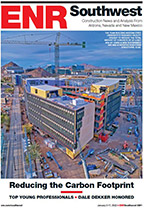FLEXLAB opens next week, yet it is already a model for similar, but smaller, test facilities in Norway and Singapore. And Webcor Builders has signed on for FLEXLAB's first private-sector project: the precommissioning of a 250,000-sq-ft headquarters building (see sidebar, p. 51).
Selkowitz says that, going forward, FLEXLAB's biggest obstacle is funding as DOE expects it to become self-sustaining. To that end, Selkowitz and FLEXLAB's manager, Cindy Regnier, are defining a business model to present to potential partners, collaborators and private-sector users. The work-in-progress is a challenge. Berkeley lab projects mainly are funded on an annual basis by DOE. There is no precedent for a self-sustaining facility. "We're breaking new ground at the lab and at DOE," says Selkowitz.
Meanwhile, outreach to grow a list of collaborators continues. FLEXLAB recently launched a buildings-sector partnership program to provide members with updates on studies. Selkowitz also is pounding the pavements to form a consortium to sponsor tests on glazed net-zero facades. "Everyone is interested, but no one is bringing out their checkbooks yet," he says.
Finally, Selkowitz has a global research network of academia, government and other institutions on his wish list. The members would share the latest test data and information on measurement techniques and repeat measurements in multiple climates.
FLEXLAB is causing a stir. To date, 1,000 visitors have taken 130 tours. Last year, Selkowitz took 18 trips, including four overseas, to spread the word.
The facility is not his only outreach project. The Berkeley lab and the non-profit Green Light New York Inc. recently partnered to study occupied office floors retrofitted with state-of-the-art lighting, daylighting and shading systems (see sidebar, above).
With so much left to do, Selkowitz has put off retirement, continuing to work 60- to 70-hour weeks. "I am optimistic we can move much of the nation's building stock toward a goal of zero-net energy," he says. "But it's a big challenge to achieve that goal in the time frame needed to slow global warming."












Post a comment to this article
Report Abusive Comment